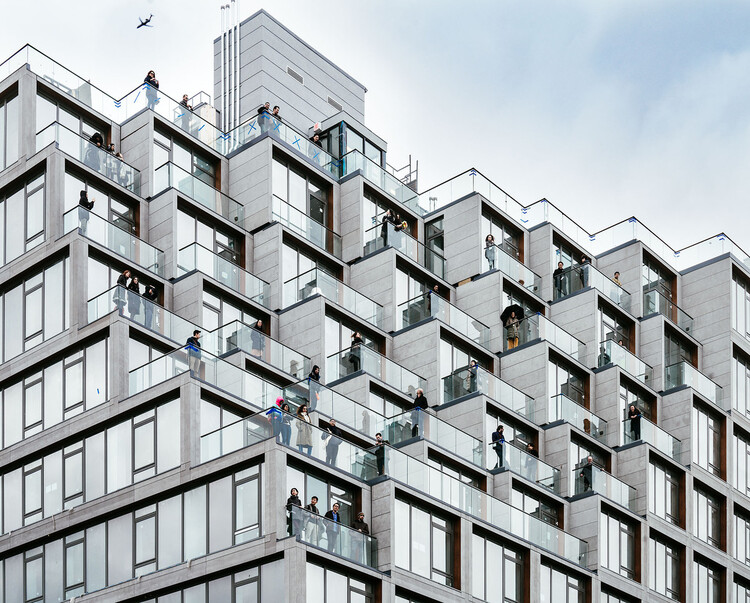
Housing production has been relying on the same spatial configurations for almost a century, catering to a vision of domestic life that no longer constitutes the norm. The widespread housing shortage, the issue of affordability, the rise of single-person households, and an aging population prompt a re-evaluation of existing housing models to address a broader range of demographics and adapt to the changing needs of city dwellers. The following explores contemporary collective housing models that provide the framework for new dwelling experiences and support current lifestyles.
The housing shortage is an important challenge for urban environments, and many cities around the world are developing plans to increase housing production. In the UK, the Affordable Homes Programme plans on delivering 82,000 new homes until 2023, while Amsterdam intends to build 52500 units by the end of 2025. For this reason, it is worth reconsidering what should a contemporary home provide and who it is designed for. For the most part, housing production continues to cater to the nuclear family. However, the number of single-person households has been steadily increasing worldwide since the 1960s. In the US, almost 30% of people live alone, and across the EU, around one-third of households are comprised of single adults, with the number getting close to 50% in Northern European countries. This data argues for a re-evaluation of housing typologies and spatial layouts.
Rethinking Mass Housing

"The community aspect of housing is going to be much more important, alongside the further integration of technology." says Ben van Berkel, founder of UNStudio, arguing that forms of community living reduce "the spatial needs compared to if everyone privately claims space for their amenities". Indeed, while it takes on many shapes, from cohousing to coliving and any variants in between, the defining characteristic of community living is shared spatial resources. In recent years, forms of community living have gained traction as a viable answer to issues such as the housing shortage, the rising costs of living, the "loneliness epidemic", and the changes within the social fabric.

Mass housing is being reconsidered from two perspectives simultaneously. On the one hand, domestic space is being redefined, and the boundary between private and public, individual and shared, is being redrawn. On the other hand, ownership and project development are also being reshaped, sometimes in opposite directions. With some versions of cohousing, residents reclaim the design and development process, giving rise to a new way of financing homeownership. At the same time, nomadic lifestyles have created the opportunity for a version of housing that resembles a subscription-based service. These aspects represent the main framework for re-evaluating mass hosing.
Residents as Developers

In Germany, the Baugruppen model is an alternative to investment-driven development in which residents become the developers, resulting in co-ownership of the communal space while residential units are individually owned. The R50 Baugruppen cohousing project in Berlin designed by Heide & von Beckerath and Ifau with Jesko Fezer is an enterprise where nineteen households pooled funds for the project's construction. The architects and the group of residents collectively selected the site, and the building was developed through participatory design, with future residents reaching a consensus on everything from common spaces to finishings. The project features an array of shared spaces, including a rooftop terrace with a summer kitchen, a group-level community room, and shared balconies that envelope the entire building. Interestingly enough, by collectively deciding on the priorities, the cost ended up being lower than that of a typical apartment in the same area.

Similarly, in their project Bay State Commons Cohousing, architecture practice French 2D engaged the future residents who were also self-developing the project into a multi-year participatory process for the design of domestic and shared spaces. In this case, the question was not only of the spatial economy but about the equitable distribution of domestic labor, as the project (currently under construction) will feature spaces where daily meals and childcare can be addressed collectively.
Open Building
The concept of "open building" was developed in the 1960s by Dutch architect John Habraken who is a champion of user participation in mass housing design. The concept promotes co-creation and co-ownership with a framework that sits somewhere in between the cohousing model and conventional mass housing developments, in the sense that it involves residents from the onset, but the users’ agency in the design is restricted to that of the individual dwelling. Object One designed by the Dutch practice Space&Matter proposes a flexible structural system that can accommodate a wide range of living scenarios. Residents can choose from 3 types of spaces within which they can design their own home according to individual needs, resulting in a mix of different-sized dwellings, some available for purchase and others to rent. “Just like a city, Object One is never finished. Similarly, Object One lives, is used for a while, and changes as the needs and wishes of residents change says Sascha Glasl, co-founder of Space&Matter.
Housing as Service

The escalating crisis of housing affordability in big cities, and economic and social changes led to the (re)birth of co-living in recent years, this micro-rental phenomenon has become a popular trend in residential real estate. Some see this commodification of space as groundbreaking, while others have compared current co-living projects with high-end dormitories for adults. Designed and managed by companies, co-living, often described as the sharing-economy version of housing, reiterates the metropolitan hotel, where occupants rent private living quarters and share access to different amenities as well as activities, based on a rolling weekly or monthly contract. The living area is reduced to a minimum and counterbalanced by an extensive communal space, a model that seeks to accommodate an increasingly large demographic of single-person households.









